Activated Carbon Filters Market Research, 2032
The global activated carbon filters market size was valued at $1.6 billion in 2022, and is projected to reach $2.6 billion by 2032, growing at a CAGR of 5.3% from 2023 to 2032.
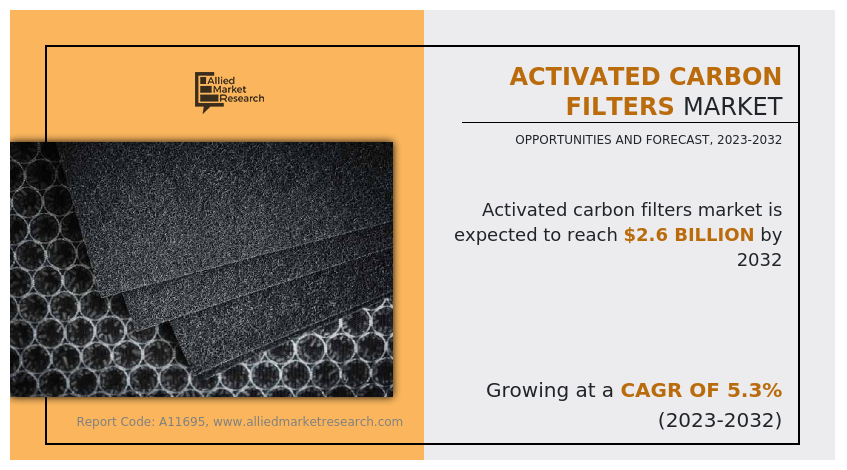
Activated carbon filters are specialized filtering systems that use activated carbon as the primary adsorbent material to eliminate impurities, contaminants, and toxins from air or water. Activated carbon is a porous type of carbon with a large internal surface area that provides several adsorption sites. The activation process includes heating carbon-rich materials at high temperatures while under the influence of steam, such as coconut shells, wood, or coal. This results in the formation of an intricate structure of pores on the carbon surface, which improves its capacity to capture and hold a wide range of chemicals.
Activated carbon filters collect airborne particles, odors, and gases in air purification systems, and they efficiently absorb soluble organic compounds, chemicals, and pollutants in water treatment. These filters are used in a variety of sectors, including air and water purification, food and beverage processing, pharmaceuticals, and others. Activated carbon filters are an important component in preserving the purity and security of air and water in a variety of situations due to their adaptability, high adsorption ability, and effectiveness in eliminating impurities. The growing awareness of health concerns has become a primary driver of consumer demand for activated carbon filters. Individuals and communities are looking for proactive methods to protect their well-being as they become more aware of the negative health impacts linked with being exposed to airborne pollutants and polluted water sources.
Activated carbon has grown in prominence in the filtration sector due to its superior adsorption properties and versatility. The benefits of activated carbon filters led to their broad acceptance across a variety of sectors, leading to the market's strong expansion. One of the primary benefits of activated carbon is its ability to efficiently remove contaminants, toxins, and pollutants from water and the atmosphere, making it a very efficient and dependable filtering option. Activated carbon filters have become commonplace in purification systems, water purification facilities, and a variety of industrial processes to improve the cleanliness of air and water. Activated carbon's adaptability in dealing with a wide range of contaminants, notably volatile organic compounds (VOCs), unpleasant smells, and substances, makes it a great option for companies that emphasize ecological and product quality. As ecological concerns and government regulations continue to stimulate demand for effective filtering solutions, activated carbon filters emerge as a top alternative, fueling their widespread adoption in addition to contributing to the general expansion of the activated carbon filters market.
Activated carbon filters have emerged as a favored alternative for lowering health concerns due to their capacity to efficiently catch and neutralize a wide variety of contaminants, including volatile organic compounds (VOCs) and impurities. People are becoming more conscious of the necessity of inhaling clean air and drinking safe, filtered water in residential, business, and industrial settings. The rising emphasis on preventative healthcare measures, along with a better awareness of the significance that air and water quality serve in general health, stimulates the need for activated carbon filters as a dependable and affordable solution to these problems. As a consequence of the need to create better living and working environments, customer demand for activated carbon filters is currently growing.
The market for activated carbon filters is facing problems due to the filters' poor efficiency against some types of pollutants. While activated carbon is very effective in adsorbing a wide range of pollutants, including organic chemicals and odors, its performance may vary depending on the contaminants. Adsorption alone may not be efficient in removing heavy metals, salts, and certain inorganic substances. This constraint impedes the broad use of activated carbon filters, especially in sectors where certain specific pollutants are prevalent.
To overcome this difficulty, ongoing research and development efforts are required to improve the adaptability and effectiveness of activated carbon filters, either by improvements to existing technology or through the incorporation of additional filtration technologies. Overcoming this barrier is critical for broadening the commercial reach of activated carbon filters and assuring their use in a wider range of industrial and environmental situations. The rising global need for clean and safe drinking water presents a significant potential for the activated carbon filters industry. With wastewater pollution and contamination becoming major issues, activated carbon filters have developed as an important water treatment technique.
Pollutants, organic compounds, and contaminants are effectively removed by these filters, guaranteeing that drinking water fulfils severe quality requirements. Consumers' rising awareness of the necessity of having access to clean water, along with increased regulatory efforts to improve water quality, is pushing the use of activated carbon filters in water treatment plants and home filtering systems. As populations grow and urbanize, the demand for dependable and effective water purification solutions rises, offering a favorable environment for the expansion of the activated carbon filters market in the context of assuring access to clean and drinkable drinking water.
Segmental Overview
The activated carbon filters market is segmented by carbon type, end user, distribution channel, and region. On the basis of carbon type, the market is classified into granular activated carbon and powdered activated carbon. Based on end user, the market is classified into residential, industrial, pharmaceutical, and food & beverages. On the basis of distribution channel, the market is classified into B2B and B2C. According to region, the market is analyzed across North America (the U.S., Canada, and Mexico), Europe (Germany, the UK, France, Italy, Spain, and the Rest of Europe), Asia-Pacific (China, Japan, India, Australia, South Korea, and the rest of Asia-Pacific), and LAMEA (Brazil, Argentina, South Africa, Saudi Arabia, and the rest of LAMEA).
By Carbon Type
Based on carbon type, the granulated activated carbon segment dominated the market in 2022 and is anticipated to propel during the forecast period. Granulated activated carbon (GAC) is the primary choice for the production of activated carbon filters for wastewater treatment. GAC's ability to absorb a wide range of pollutants, including organic toxins and chlorine, makes it a popular option in municipal water treatment facilities and domestic water filtration systems.
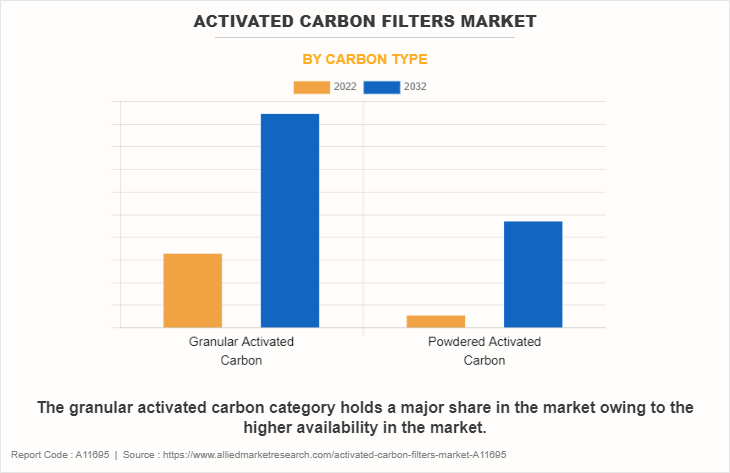
By End User
As per end user, the industrial segment dominated the market in 2022 and is anticipated to propel during the activated carbon filters market forecast period. Activated carbon filters are being adopted by industries for their efficient solutions for reducing emissions and cleaning process water, harmonizing with worldwide initiatives to decrease environmental impact. Customizing activated carbon filters for specific industrial applications such as gas filtration in the manufacturing sector or sewage treatment in the chemical industry is gaining attention. Furthermore, the requirement for activated carbon filters in the industrial sector is increasing because of a growing understanding of safety and health at work, with companies prioritizing worker well-being by building strong air purification systems.
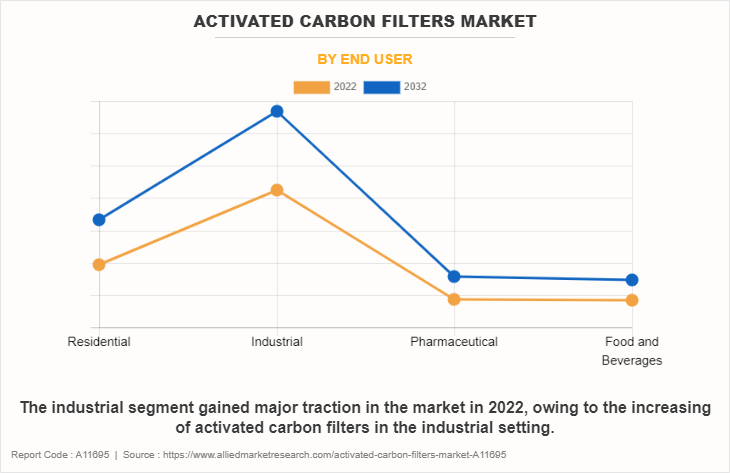
By Distribution Channel
Depending on the distribution channel, the B2B segment dominated the market in 2022 and is projected to continue the same trend during the forecast period. The increasing integration of digital technologies in B2B sales processes, facilitating efficient online transactions, order tracking, and streamlined communication between manufacturers and distributors is fueling the activated carbon filters market growth for B2B distribution channel. Furthermore, the emphasis on product customization to satisfy particular industrial demands is opening up chances for manufacturers and distributors to work closely together, delivering personalized solutions for a wide range of applications such as air purification, water treatment, and industrial processes.
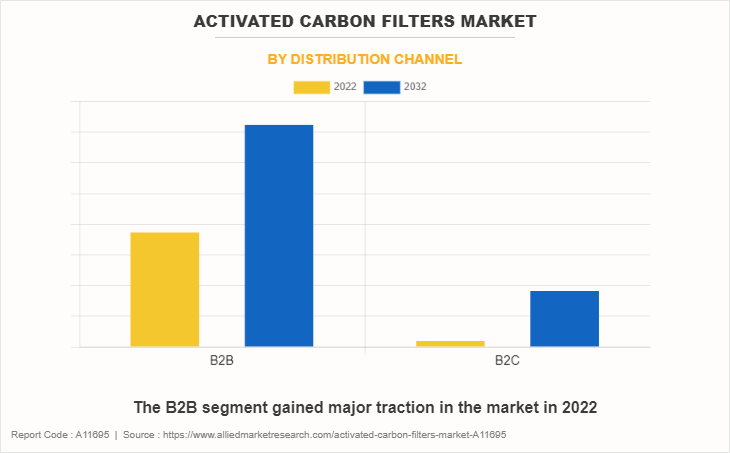
By Region
According to region, Asia-Pacific dominated the activated carbon filters market in 2022 and is expected to continue the same trend during the forecast period. The growing emphasis on environmental sustainability, as well as the strict rules enacted by several nations to combat air and water pollution, is fueling the growth of activated carbon filters in Asia-Pacific. The region's fast development and urbanization lead to increased concerns about air quality, pushing activated carbon filters market demand for effective air filtration systems that use activated carbon filters.
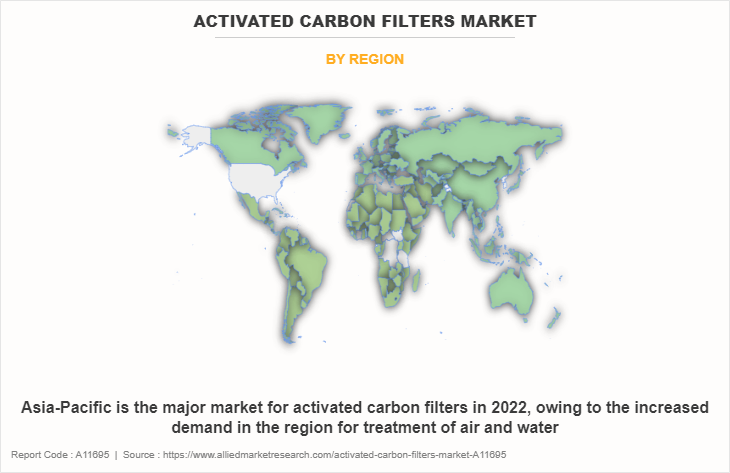
Competition Landscape
Players operating in the activated carbon filters industry have adopted various developmental strategies to expand their activated carbon filters market share, increase profitability, and remain competitive in the market. Key players profiled in this report include Ecolab, WesTech Engineering, LLC, 3M, CPL Activated Carbons, Lenntech B.V., Kuraray Co., Ltd., General Carbon Corporation, Chemietron Clean Tech Pvt. Ltd., Sereco Srl, and TIGG LLC.
Examples of Expansion in the Global Activated Carbon Filters Market
- Kuraray Co., Ltd. with its subsidiary Calgon Carbon Corporation announced expansion at its Pearlington, Mississippi site in order to expand its activated carbon production line.
Examples of Partnership in the Global Activated Carbon Filters Market
- Kuraray Co., Ltd. partnered with PTT Global Chemical Public Company Limited (GC) and Sumitomo Corporation in order to open a manufacturing plant under the name of Kuraray GC Advanced Materials Co., Ltd. and Kuraray Advanced Chemicals (Thailand) Limited.
Key Benefits For Stakeholders
- This report provides a quantitative analysis of the market segments, current trends, estimations, and dynamics of the activated carbon filters market analysis from 2022 to 2032 to identify the prevailing activated carbon filters market opportunities.
- The market research is offered along with information related to key drivers, restraints, and opportunities.
- Porter's five forces analysis highlights the potency of buyers and suppliers to enable stakeholders make profit-oriented business decisions and strengthen their supplier-buyer network.
- In-depth analysis of the activated carbon filters market segmentation assists to determine the prevailing market opportunities.
- Major countries in each region are mapped according to their revenue contribution to the global market.
- Market player positioning facilitates benchmarking and provides a clear understanding of the present position of the market players.
- The report includes the analysis of the regional as well as global activated carbon filters market trends, key players, market segments, application areas, and market growth strategies.
Activated Carbon Filters Market Report Highlights
| Aspects | Details |
| Market Size By 2032 | USD 2.6 billion |
| Growth Rate | CAGR of 5.3% |
| Forecast period | 2022 - 2032 |
| Report Pages | 258 |
| By End User |
|
| By Carbon Type |
|
| By Distribution Channel |
|
| By Region |
|
| Key Market Players | Sereco Srl, Lenntech B.V., WesTech Engineering, LLC, Kuraray Co., Ltd., Newterra, CPL Activated Carbons, Ecolab, 3M, General Carbon Corporation, Chemietron Clean Tech Pvt. Ltd. |
Analyst Review
According to the CXOs, the rising deployment of activated carbon filters across sectors is a noticeable trend, owing to an increasing focus on the preservation of the environment and the necessity for effective pollution management. With regulatory authorities throughout the world demanding tougher criteria for air and water purity, the need for innovative filtering systems is increasing. Technological improvements, such as innovations in activated carbon manufacturing processes and the incorporation of smart technologies in filtration systems, are important reasons driving market expansion.
Furthermore, the increase in industrial activity, particularly in emerging nations, promises significant growth potential for activated carbon filters in tackling air and water pollution issues. The ability to customize filter design to meet unique industrial demands has been identified as a crucial development factor. Industry experts also stress the necessity of collaborations and partnerships between producers and end-users in developing personalized solutions that satisfy changing regulatory requirements and customer demands.
The activated carbon filters market was valued at $1,578.2 million in 2022 and is projected to reach $2,612.1 million by 2032, growing at a CAGR of 5.3% during the forecast period.
The global activated carbon filters market registered a CAGR of 5.3% from 2023 to 2032.
Raise the query and paste the link of the specific report and our sales executive will revert with the sample.
The forecast period in the activated carbon filters market report is from 2023 to 2032.
The top companies that hold the market share in the activated carbon filters market include Ecolab, WesTech Engineering, LLC, 3M, CPL Activated Carbons, Lenntech B.V., Kuraray Co., Ltd. and others.
The activated carbon filters market report has 2 segments. The segments are carbon type, end user, and distribution channel.
The emerging countries in the activated carbon filters market are likely to grow at a CAGR of more than 7.7% from 2023 to 2032.
Post-COVID-19, global industry is expected to grow at a high rate as market leaders adopt new partnerships for introducing new filter technologies and offer unique experience to the consumers.
Asia-Pacific will dominate the activated carbon filters market by the end of 2032.
Loading Table Of Content...
Loading Research Methodology...



